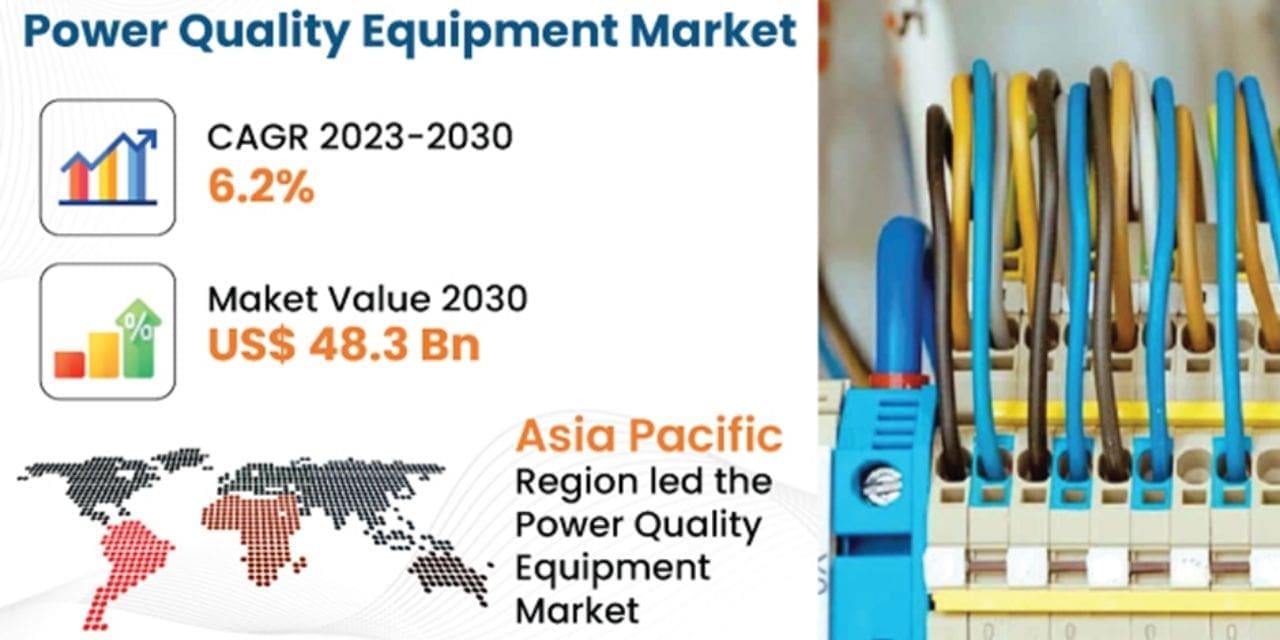An assortment of apparatuses intended to manage, regulate, and improve the quality of electrical power is referred to as power quality equipment. Fundamentally, it deals with problems like harmonics, sags, surges, voltage fluctuations, frequency variations, and interruptions. If these problems are not resolved, they may result in data loss, device failure, decreased productivity, and even safety risks.
The power quality equipment market is expected to grow at an impressive compound annual growth rate (CAGR) of 6.2% from 2023 to 2030, reaching US$48.3 billion, according to Fairfield Market Research. The industry’s emphasis on operational efficiency and dependability is driving this rise, which is indicative of a rising demand for solutions addressing voltage variations and harmonics. It is anticipated that investments in power quality equipment will soar, stimulating innovation and industry growth. This trajectory represents a significant turn in the direction of improving the resilience of the electrical infrastructure and guaranteeing a continuous supply of electricity to a variety of sectors.
Types of Power Quality Equipment
- Voltage Regulators: Voltage fluctuations are a common occurrence in electrical systems, often stemming from grid instability or large equipment switching on/off. Voltage regulators ensure a stable output voltage, mitigating the risk of equipment damage and ensuring consistent performance.
- Uninterruptible Power Supplies (UPS): UPS systems act as a safety net during power outages, providing seamless transition to backup power sources. Beyond preventing downtime, modern UPS units offer features like voltage regulation, surge protection, and harmonic filtering, enhancing power quality further.
- Transient Voltage Surge Suppressors (TVSS): Transient voltage spikes, typically caused by lightning strikes or switching operations, pose a significant threat to sensitive electronic equipment. TVSS devices divert excess voltage away from connected devices, safeguarding them against damage.
- Power Conditioners: These devices improve power quality by filtering out harmonics, noise, and other disturbances present in the electrical supply. By delivering clean and stable power, power conditioners enhance the performance and lifespan of connected equipment.
- Active Power Filters: Active power filters actively monitor the electrical waveform and inject corrective currents to mitigate harmonic distortions and improve power factor. They are particularly effective in industrial settings where nonlinear loads are prevalent.
Key Trends:
- Digitalization and Connectivity: The connected digital ecosystem is seeing a growing integration of power quality equipment, which makes communication between devices, systems, and stakeholders easier. This trend promotes operational agility and efficiency by enabling remote monitoring, control, and optimization.
- Energy Storage Integration: Energy storage systems that are integrated with power quality equipment improve resilience and reliability by mitigating fluctuations in renewable energy supply and offering backup power during outages. This pattern corresponds with the rising need for a stable energy supply and a stable grid.
- Focus on Resilience and Reliability: In an era characterized by catastrophic weather events brought on by climate change and cybersecurity threats, the importance of developing robust and dependable electrical infrastructure is rising. Equipment for power quality is essential for protecting crucial systems and guaranteeing business continuity.
- Regulatory Compliance: Adoption of power quality equipment is driven by changing regulatory frameworks with the goals of lowering emissions, increasing energy efficiency, and improving grid dependability. Observance of rules and regulations turns into a major factor influencing investment in these technologies.
Impact on Different Sectors
- Industrial: In industrial environments, where heavy machinery and sensitive control systems coexist, any deviation in power quality can have dire consequences. Power quality equipment ensures continuous operation, prevents equipment damage, and maintains production efficiency.
- Commercial: From office buildings to retail establishments, maintaining a conducive environment for electronic devices is essential. Power quality equipment protects critical infrastructure, such as servers and HVAC systems, ensuring uninterrupted business operations.
- Healthcare: In healthcare facilities, where uninterrupted power is a matter of life and death, power quality equipment plays a vital role. UPS systems provide backup power to medical equipment, while voltage regulators maintain stable conditions for sensitive devices like MRI machines and life support systems.
- Residential: Even in residential settings, power quality issues can disrupt daily life. UPS units offer peace of mind during outages, while surge suppressors protect valuable electronics from voltage spikes.
Challenges:
- Technological Complexity: As electrical systems become more intricate, managing power quality issues grows increasingly complex. Addressing factors like harmonics, voltage fluctuations, and transient surges requires sophisticated solutions capable of adapting to dynamic environments.
- Cost Constraints: While power quality equipment offers significant benefits, the initial investment and ongoing maintenance costs can be prohibitive for some organizations, particularly smaller businesses and residential consumers.
- Integration Issues: Retrofitting existing infrastructure with power quality equipment can be challenging, especially in older buildings or industrial facilities with outdated electrical systems. Seamless integration and compatibility with existing equipment are essential to avoid disruptions.
- Cybersecurity Risks: With the rise of connected devices and IoT integration, power quality equipment becomes vulnerable to cyber threats. Ensuring robust cybersecurity measures to protect against potential attacks is crucial to maintaining system integrity and reliability.

